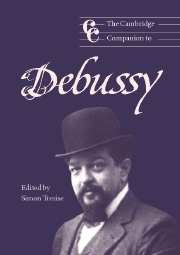Book contents
- Frontmatter
- Introduction
- Part I Man, musician and culture
- Part II Musical explorations
- 4 Debussy on stage
- 5 The prosaic Debussy
- 6 Debussy and expression
- 7 Exploring the erotic in Debussy's music
- 8 Debussy and nature
- Part III Musical techniques
- Part IV Performance and assessment
- Notes
- Select bibliography
- Index
6 - Debussy and expression
from Part II - Musical explorations
Published online by Cambridge University Press: 28 September 2011
- Frontmatter
- Introduction
- Part I Man, musician and culture
- Part II Musical explorations
- 4 Debussy on stage
- 5 The prosaic Debussy
- 6 Debussy and expression
- 7 Exploring the erotic in Debussy's music
- 8 Debussy and nature
- Part III Musical techniques
- Part IV Performance and assessment
- Notes
- Select bibliography
- Index
Summary
I feel more and more that music, by its very essence, is not something that can flow inside a rigorous, traditional form. It consists of colours and of rhythmicised time . . .
The works to be discussed in this chapter include three of Debussy's greatest pieces for orchestra, all of them explicitly evocative: the Nocturnes, La mer and ‘Ibéria’ from the orchestral Images. In addition, the three piano pieces composed at about the same time as Lamer–Masques, D'un cahier d'esquisses and L'isle joyeuse – will be considered from the point of view of Debussy's expressive intentions. Among his orchestral works, the score of ‘Ibéria’, in particular, is teeming with expression marks which give important clues to the atmospheric evocation he sought to achieve – an innovative practice at the time and one which has sometimes been misunderstood as the quest for a rather generalised kind of poetic or naturalistic allusiveness in music, or simply a vaguely defined effect. But the very precision of Debussy's performance instructions in this instance suggests an entirely different interpretation: that as he refined his command of music's expressive potential, so his intentions were not only to give indications of tempo, dynamics and articulation, but also to specify the emotional and expressive content of a note, a phrase, a section or even a whole piece. For other works the scores themselves contain many fewer clues, but valuable evidence of Debussy's expressive and musical thought processes can be found in his letters and writings – both rich seams of self-revelation.
- Type
- Chapter
- Information
- The Cambridge Companion to Debussy , pp. 101 - 116Publisher: Cambridge University PressPrint publication year: 2003
- 2
- Cited by

